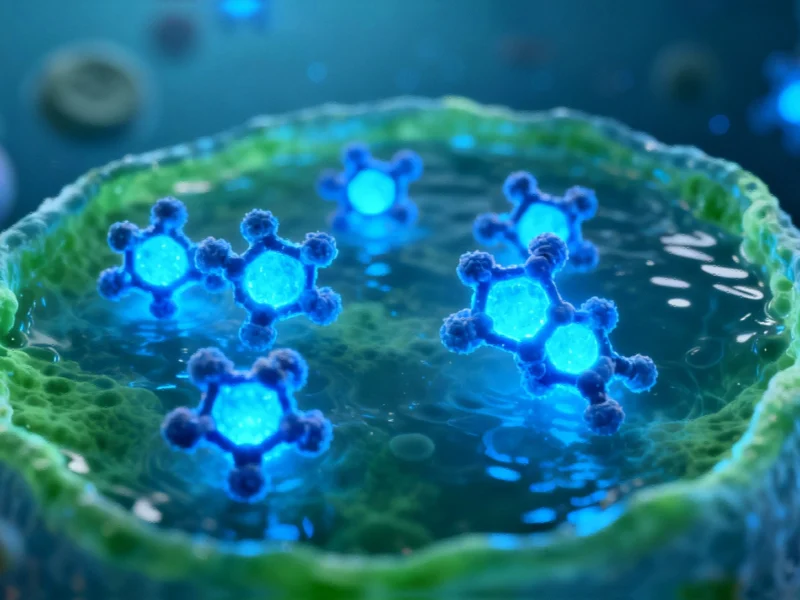In a stunning reversal of conventional chemical behavior, scientists at the University of Malaga and IBIMA Plataforma BIONAND have developed a remarkable family of fluorescent molecules that actually increase their brightness in water-based environments—the exact opposite of what typically occurs with fluorescent dyes. This breakthrough, detailed in the prestigious journal Advanced Materials, represents a significant leap forward for biomedical imaging and cellular research.
The research team, comprising experts from the Departments of Physical Chemistry and Organic Chemistry, has created what they describe as “counterintuitive” molecules that shift their coloration toward the blue spectrum while simultaneously boosting fluorescence intensity when dissolved in aqueous media. This phenomenon directly contradicts the established pattern where most fluorescent molecules lose intensity or become duller in biological environments. As recent advances in molecular imaging technology continue to evolve, this discovery stands out for its practical implications in real-world biomedical applications.
The Science Behind the Glow
What makes these molecules truly extraordinary is their inverted behavior pattern. Traditional fluorescent dyes typically experience what scientists call “quenching” in aqueous solutions—their light-emitting properties diminish precisely when researchers need them most. These new molecules defy this principle by enhancing their luminous properties in the exact conditions where cellular imaging occurs.
“These results are tremendously encouraging,” stated UMA Professors Ezequiel Pérez-Inestrosa and Juan Casado, who co-directed the study. “Not only do these molecules challenge an established rule in fluorescent chemistry, but they also open the door to new tools for studying diseases where mitochondrial function is key.” The research team included José Manuel Marín Beloqui, Juan T. López Navarrete, Juan Casado Cordón, Carlos Benítez Martín, and Francisco Nájera Albendín, representing a collaborative effort between fundamental chemistry research and applied biomedical science.
Practical Applications in Cellular Imaging
The implications for biomedical research are substantial. These novel fluorescent molecules enable researchers to visualize cellular interiors with unprecedented clarity using multiphoton microscopy—a technique that allows deeper penetration into living tissues without causing damage. This advancement comes at a time when advanced imaging fusion techniques are revolutionizing how we understand cellular structures and functions.
Perhaps most significantly, these molecules demonstrate a remarkable ability to selectively target and illuminate mitochondria—the cellular powerhouses responsible for energy production. This specific targeting capability provides researchers with powerful new tools to study diseases where mitochondrial dysfunction plays a critical role, including cancer and neurodegenerative conditions like Alzheimer’s and Parkinson’s disease.
Advantages Over Existing Technologies
Beyond their unique fluorescent properties, these molecules offer practical benefits that could accelerate their adoption in research and clinical settings. The experimental results show that these new molecules produce image quality comparable to existing fluorescent markers, but with two crucial advantages: they’re significantly easier to manufacture and more cost-effective to produce.
This combination of enhanced performance and reduced production complexity could make advanced diagnostic tools more accessible to research institutions and medical facilities worldwide. The development aligns with broader trends in breakthrough imaging technology that’s making sophisticated cellular analysis more widely available.
Broader Scientific Context
This discovery fits within a larger movement toward improved visualization techniques in biological research. Recent developments in new measurement methods for visualizing chemical signals have highlighted the growing importance of precise imaging in understanding cellular processes. Meanwhile, AI breakthroughs in modeling cellular drug interactions demonstrate how computational methods are complementing experimental imaging techniques.
The timing of this fluorescent molecule development is particularly relevant as researchers seek better ways to understand complex biological systems. As noted in a global study on cellular impacts, the ability to clearly visualize intracellular components without damaging living tissue represents a critical advancement in both basic research and clinical applications.
Future Directions and Potential Impact
The research team emphasizes that this represents more than just a laboratory curiosity—it’s a practical tool that could transform how we study disease mechanisms and develop treatments. The molecules’ ability to maintain and enhance fluorescence in aqueous environments means they could be used for extended observation of living cells, providing insights into dynamic cellular processes that were previously difficult to capture.
As the scientific community continues to explore the full potential of these molecules, researchers anticipate applications ranging from basic cell biology studies to advanced diagnostic platforms. The combination of improved performance, selective mitochondrial targeting, and cost-effective production positions this technology as a potentially transformative tool in the ongoing effort to understand and treat complex diseases at their most fundamental level.
Based on reporting by {‘uri’: ‘phys.org’, ‘dataType’: ‘news’, ‘title’: ‘Phys.org’, ‘description’: ‘Phys.org internet news portal provides the latest news on science including: Physics, Space Science, Earth Science, Health and Medicine’, ‘location’: {‘type’: ‘place’, ‘geoNamesId’: ‘3042237’, ‘label’: {‘eng’: ‘Douglas, Isle of Man’}, ‘population’: 26218, ‘lat’: 54.15, ‘long’: -4.48333, ‘country’: {‘type’: ‘country’, ‘geoNamesId’: ‘3042225’, ‘label’: {‘eng’: ‘Isle of Man’}, ‘population’: 75049, ‘lat’: 54.25, ‘long’: -4.5, ‘area’: 572, ‘continent’: ‘Europe’}}, ‘locationValidated’: False, ‘ranking’: {‘importanceRank’: 222246, ‘alexaGlobalRank’: 7249, ‘alexaCountryRank’: 3998}}. This article aggregates information from publicly available sources. All trademarks and copyrights belong to their respective owners.



